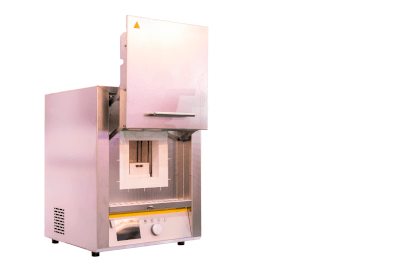What Is a Muffle Furnace?

A muffle furnace is a furnace in which a magnetic heating plate is placed inside the furnace, and the heat source is not directly exposed to the sample by using a partition wall (muffle) in which the heater is not exposed.
Electric furnaces used for ceramics and other applications are distinguished from muffle furnaces by the use of exposed heaters inside the furnace.
The metal or powder to be heated, melted, or dried is not directly exposed to the heat source, but the sample is indirectly exposed to the heat source, thus preventing contamination of the sample.
Ceramic fiber, an inorganic fiber mainly composed of alumina and silica, is used as the insulation material inside the furnace and is a chemically stable material resistant to rapid heating and cooling.
Some models can be program-controlled to raise and lower the temperature.
Temperature sensors include R thermocouples, K thermocouples, and B thermocouples, which have different materials and temperature ranges. Therefore, the use of appropriate sensors is recommended.
As safety devices, overcurrent breakers and microcomputer error detection devices are provided.
Uses of Muffle Furnaces
Muffle furnaces are used for firing ceramics (tiles, glass, and insulators) because the atmosphere inside the furnace changes little and requires precise control.
In component analysis tests for heavy metals, arsenic, etc., samples are pretreated and ashed in a muffle furnace for analysis and used in trials for pharmaceuticals and foods.
Muffle furnaces measure the amount of residual material in ashing tests and pharmaceutical and food testing.
Muffle furnaces are used for the heat treatment of glass and metals.
Principle of Muffle Furnaces
The heat source does not expose the heater inside the furnace. The furnace body covers the heater so that the heat source does not directly contact the specimen, eliminating the risk of contamination.
Since the heat source is covered by a bulkhead and not directly exposed, the furnace is made of ceramic fiber with excellent heat insulation and heat retention properties. There are few sudden changes in the atmosphere inside the furnace, and precise temperature control is possible.
Heat plates emitting heat sources are arranged on four sides of the furnace, top, bottom, left, and right, enabling fast temperature rise.
The heat source is an iron chrome wire (normal operating temperature: 850°C) or molybdenum disilicide for higher temperature use (1600°C).
The principle of this heating method is to generate heat by passing an electric current through resistance heating, which is highly efficient because 100% of electrical energy converts into heat.
JIS standard thermocouples, such as R, K, and B, are used as temperature sensors, each of which has a different specified temperature range.
A thermocouple is a temperature sensor consisting of two different types of metal conductors. The difference between the temperature of the object and the room temperature, for example, is detected as an electrical signal.
Since JIS standards control the temperature sensor, it provides reliable temperature control inside the furnace.
To prevent damage, there is a gap between the door and the furnace body (main body), each with a different expansion rate due to heat.